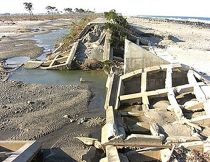Development of new coast defense structures resistant to tsunamis and high tide

- researcher's name
-
about researcher SHIBAYAMA, Tomoya Professor (retired)
- affiliation
- research field
-
Hydraulic engineering
- keyword
-
background
During the tsunami in Tohoku in 2011, the bay seawalls, seawalls, and coastline seawalls failed in succession. The various defense mechanisms were unable to prevent the tsunami damage that occurred. Taking into consideration case studies from the local area on the damage mechanism for each type of defense, this project runs hydraulic model tests and quantitative simulations to elucidate such damage mechanisms.
summary
In line with the rebuilding of coastline defense structures across the country as each location reaches its scheduled upgrade period, there is a need to shift the structural format used for coastal defense. This project proposes a new structural format that considers knowledge gained from the elucidation of damage mechanisms and the impact on the coastal environment.
application/development
In the case of tsunami defense seawalls installed underwater, the project constructs structures responsive to environmental problems by introducing functions such as improving the water quality within harbors.
predominance
The project takes a comprehensive view on research into tsunamis and high-tide disaster mechanisms that have taken place over a 35-year time span, as well as research into the ecological maintenance of enclosed sea areas, and proposes and designs the most appropriate structure for each area.
purpose of providing seeds
Sponsord research, Collaboration research, Technical consultation
material
posted:
2014/05/21




